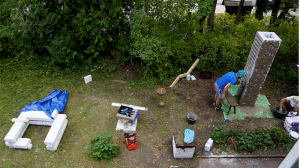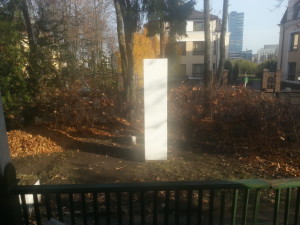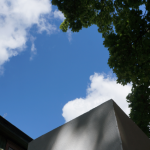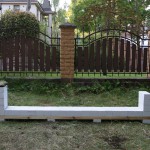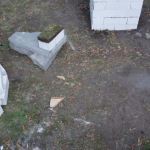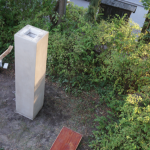
Project Space As a Playground For Traveling Artists
2015-09-09
On top of the lawn
Around 6pm each day the sun begins its descent, drooping from the sky until it finds a place in front of a tall glass building next to the Lithuanian Parliament. Once it hits the belly of the hi-rise, its light then projects across the Neris River, dodging a few trees onto the patchy lawn of Malonioji 6. A second sun, setting from the east.
A defining feature of the neighborhood we’re working in is that the very way in which yards are partitioned presents its own argument about the limitations of property: barely a fence, an impaling fence, brick columns with a fence, brick columns with an impaling fence. Almost entirely residential, newly painted Tuscan Villas cover a number of the plots, holding the spatial fabric together while older wooden constructions continue to decay, seemingly left behind from somewhere on the eastside of Detroit. Each day the monolith we’re building begins to peek its head above the bushes a little bit more, its body cut at the waist by a thin, mesh fence. From the porch this oversized pedestal approaches a conversation with the not-so distant skyline, muted amidst its reflections. From the street it appears to hold the porch in place. A group of boys push around on the pavement in front of the house and play s-k-a-t-e on a regular basis, filling the air with sudden bursts of noise. Their tricks fall mostly un-landed in front of a private area for trash. Although partially obstructed from view, the trash zone was designed to be seen as an extension of the Villa aesthetic and is indicative of the changes at play in the architecture of the neighborhood. Properties which used to house summer homes for the wealthy are now falling back into the landscape, while the new single-family structures are returning to function as they may have one hundred years ago, but this time with flat, pastel-toned facades. To the right of Malonioji 6, there’s another new Villa where a Porsche slides in and out of the garage on occasion, the iron fence terminating in severe decorative spikes. On the corner, two trailers that transport rows of different colored kayaks to and from the river are parked nightly in front of the house. On the way to lunch, Albert talks about a performance of dumping them into the Neris all at once.
One afternoon when Helmut had just finished placing the last row of bricks on the pedestal, a neighbor called us over to have a conversation through the fence. His politeness was unsettling because it was simultaneously direct and oblique. He complemented Helmut for his professionalism and skill with the bricks but said that because Vilnius sits within a valley the smoke from our fire would have nowhere to go and cloud up the entire city. And although he supports both the arts and sports, if we use our sculpture to barbecue, he would in fact be the one who calls the cops. He told us that we’re not fifteen anymore and can’t do whatever we want without regard for our surroundings. He says barbecuing is also against social law, which of course he not only defines but is in the midst of trying to uphold. That night we didn’t barbeque.
After that interaction, one of our hosts did some research into it. She finds out that barbequing is in fact legal but it just needs to happen at a minimum of six meters from the house. For us, that would mean on the edge of the sidewalk. From this a conversation comes up about whether actually using the sculpture as a barbeque is worth it or if it sitting as a representation of the legal boundaries and relationship to the neighbors would better activate its artistic potential. Our primary conceptual material, living and / or working, had begun to enter into a feedback loop through which we could then re-encounter the site. Sculptures to sit on, eat from, and prepare other sculptures out of. We’re told the amount of waste we’ve generated is unprecedented for that space. Hopefully a surplus of meaning finds its way back into the cycle as well.
For the opening we flirt with a series of ideas about how the front lawn could behave: a whimsical sculpture garden, a social space to welcome skeptical neighbors, an outdoor exhibition indebted to minimalist tropes, or an archive dedicated to the processes and trials of its own making. We talk about the difference between the visual and the social, and about the space being spare enough to invite the imagination, yet still maintain some of the intensity experienced by being present and rearranging the ways in which the front lawn was occupied over the course of our week there.
Tonight there’s a certain sadness to our monolith. It’s alone without any relatives to soften its context, holding nothing but the air above itself. Its quiet seems to be its most ambitious feature: an oversized chimney posing as a pedestal waiting to be used in the double sense. It has become a shadow of sorts for how we understand this place. Never directly addressing the dynamic of Malonioji, it simply sits there in its blank severity. The process of raising it, and occupying the space necessary to raise it, has in effect introduced us to our temporary surroundings. We grill corn and sausages knowing that we’ll be leaving in the morning. An older man who doesn’t speak much English says he wants to write about us in a newspaper his uncle runs. He comes to most of their openings, announces a different profession each time and leaves with a pocketful of email addresses.
Seth Weiner
2015
Gruppe Uno Wien
Living / and / or Working
Project funded by the Ministry of Culture of the Republic of Lithuania and Lithuanian Council For Culture.
Photos Evelina Kerpaitė and gruppe uno wien

